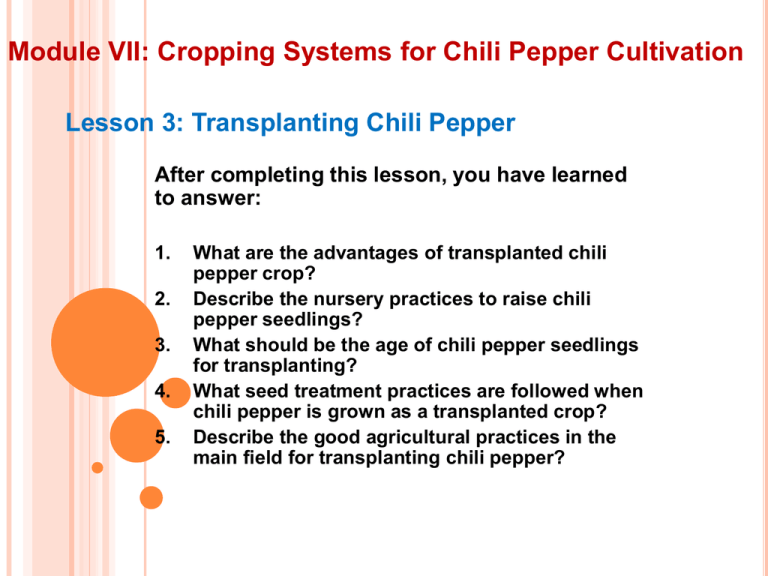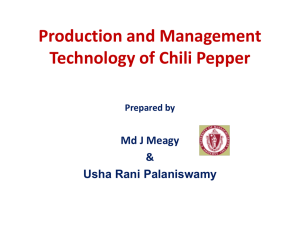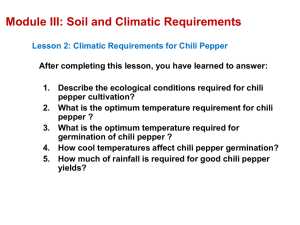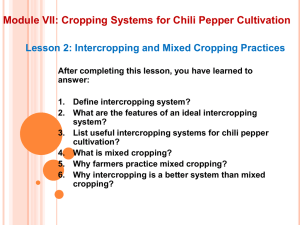Module VII: Cropping Systems for Chili Pepper Cultivation
advertisement

Module VII: Cropping Systems for Chili Pepper Cultivation Lesson 3: Transplanting Chili Pepper After completing this lesson, you have learned to answer: 1. 2. 3. 4. 5. What are the advantages of transplanted chili pepper crop? Describe the nursery practices to raise chili pepper seedlings? What should be the age of chili pepper seedlings for transplanting? What seed treatment practices are followed when chili pepper is grown as a transplanted crop? Describe the good agricultural practices in the main field for transplanting chili pepper? Module VII: Cropping Systems for Chili Pepper Cultivation Lesson 3: Transplanting Chili Pepper Transplanted chili pepper crop, though a common cropping practice in many chili pepper areas, is not practiced in certain parts of India. There should be assured availability of water for raising a nursery and irrigating the transplanted chili pepper crop. Module VII: Cropping Systems for Chili Pepper Cultivation Lesson 3: Transplanting Chili Pepper Transplanted crop has the following advantages: • Main field duration is reduced by 10 days; • Optimum population can be maintained as only healthy seedlings are used for transplanting; • Seed rate can also be reduced by 2.5 Ib/acre. Module VII: Cropping Systems for Chili Pepper Cultivation Lesson 3: Transplanting Chili Pepper Nursery practices Chili pepper seedlings are raised in 7.5 cents (300 m2) near a water source, to plant one hectare. 750 kg of FYM or compost is applied in 7.5 cents nursery and another 500 kg of compost or FYM is applied for covering the seeds after sowing. Module VII: Cropping Systems for Chili Pepper Cultivation Lesson 3: Transplanting Chili Pepper Nursery practices The 300 m2 area is divided into 3 raised beds of 2m x 1.5m with 30 cm space in between the beds. Channels of 15cm depth are formed around the beds for irrigation. Module VII: Cropping Systems for Chili Pepper Cultivation Lesson 3: Transplanting Chili Pepper Nursery practices The following are the seed treatment practices: Seeds are treated with Trichoderma viride at 4g/kg of seed and with three packets each of Azospirillum (600 g) and Phosphobacterium to enhance the availability of nitrogen and phosphorus. The seeds are soaked in 30% salt solution (3 kg of common salt in 10 liters of water). Ergot affected seeds which float are removed to avoid the incidence of ergot disease. Module VII: Cropping Systems for Chili Pepper Cultivation Lesson 3: Transplanting Chili Pepper Nursery practices The following are the seed treatment practices: Seed hardening is done by soaking the seeds in 2% (20 g in one liter of water) potassium dihydrogen phosphate solution for 6 hours. Use 350 ml of solution for soaking one kg of seed. Dry the seed in shade to original moisture level. Module VII: Cropping Systems for Chili Pepper Cultivation Lesson 3: Transplanting Chili Pepper Nursery practices 7.5 Ib of treated seeds are sown broadcast evenly on the beds. The seeds are covered by passing the hands lightly over the soil ensuring that the seeds are not sown deep as germination will be affected. Module VII: Cropping Systems for Chili Pepper Cultivation Lesson 3: Transplanting Chili Pepper Nursery practices The beds are irrigated as per the following schedule: Iriigation Red Soils (Days after sowing) Heavy Soils (Days after sowing) First Irrigation Immediately after sowing Immediately after sowing Second Irrigation Third Fourth Third Irrigation Seventh Ninth Fourth Irrigation Twelfth Sixteenth FifthIrrigation Seventeeth Nil Module VII: Cropping Systems for Chili Pepper Cultivation Lesson 3: Transplanting Chili Pepper Main field practices Ridges and furrows are formed 45 cm apart. Alternatively, form beds of size 10 m2 or 20 m2 depending on the availability of water. Irrigation channels are formed to evenly distribute water. Seedlings of 15 to 18 days are planted on the top of the ridges. Seedlings of above 18 days will not establish properly or may die. Module VII: Cropping Systems for Chili Pepper Cultivation Lesson 3: Transplanting Chili Pepper Main field practices 1000 g/ha of Azospirillum inoculant is prepared in 40 liters of water and the root portion of the seedlings are dipped in this solution for 15-30 minutes before transplanting. The seedlings are planted at 5 cm depth and15 cm apart on the side of the ridge, half the distance from the top and bottom of the ridge. Fertilizers are applied based on the soil test report. Module VII: Cropping Systems for Chili Pepper Cultivation Lesson 3: Transplanting Chili Pepper Main field practices In the absence of soil test recommendations, a blanket recommendation of 90 N, 45 P2O5, 45 K2O Ib/acre is adopted. Half the dose of nitrogen and full dose of P2O5, and K2O are applied before planting. The fertilizers are placed on two-thirds top side of the ridges at 5 cm depth and covered. The balance nitrogen dose is applied 15 days of planting and irrigated. Module VII: Cropping Systems for Chili Pepper Cultivation Lesson 3: Transplanting Chili Pepper Main field practices Irrigation schedule is followed depending on the soil and weather conditions. Crop Stage Irrigations After sowing Germination or establishment 1 2 1st day 4th day 1 2 15th day 28th day 1 2 3 40 th day 52nd day 64th day 1 2 75th day 88th day Regulate irrigation during vegetative phase Flowering phase (copious irrigation) Maturity phase (control irrigation) Stop irrigation thereafter Module VII: Cropping Systems for Chili Pepper Cultivation Lesson 3: Transplanting Chili Pepper With this, the Lesson 4 - Transplanting Chili pepper, and also this Module on Cropping Systems for chili pepper cultivation concludes.






